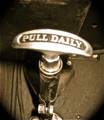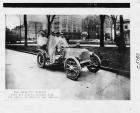|
Re: Rebuilding the Carter WGD
|
||||
|---|---|---|---|---|
|
Home away from home

|
Hans,
The automatic choke heat receives warm air from the manifold because of the pressure difference between the manifold and the choke spring housing (which is open to the atmosphere, or should be). Here is a manual I found for that carburetor. Sorry, but I can't help with your other questions. Cheers, Tom
Posted on: 2013/2/15 8:02
|
|||
|
||||
|
Re: Rebuilding the Carter WGD
|
||||
|---|---|---|---|---|
|
Forum Ambassador

|
In answer to some of your questions, in proper working order the Carter Climatic Control automatic choke was a good design and worked very well. Wear in the base casing at the throttle shaft bores is encountered commonly enough and the better carburetor rebuilders service it the same way you've suggested - by boring and installing bushings and if necessary a new shaft. To find a fuel bowl empty after sitting for a month is entirely normal, the bowl is vented to the atmosphere and that's more than enough time for the fuel to evaporate.
The WDG is a very good design and given a proper rebuild, I'm sure you'll be very happy with the results.
Posted on: 2013/2/15 9:30
|
|||
|
||||
|
Re: Rebuilding the Carter WGD
|
||||
|---|---|---|---|---|
|
Just can't stay away
|
Thanks for the info Tom. The service manual is very useful. In the meantime I've rebuilt the housing and the top of the carburetor. What remains is the throttle shaft issue and the welsh plug.
Should be back on the car in a couple of days, ready for spring season. Hans
Posted on: 2013/2/15 13:09
|
|||
|
All the best from Holland!
Hans Clipper Deluxe Touring sedan 1954 |
||||
|
||||
|
Re: Rebuilding the Carter WGD
|
||||
|---|---|---|---|---|
|
Just can't stay away
|
Good to hear satisfying experiences with the WGD. So after putting it all together again I will be checking the adjustments to make sure everything is spot on.
What in your opinion would be a good method to start the engine after the fuel in the bowl has evaporated? I guess a little fuel down the venturi would help? A friend of mine has a WW 2 Ford Jeep. His fuel pump has a maual lever that helps bringing up te fuel, quite useful. Thanks for responding! Hans
Posted on: 2013/2/15 13:15
|
|||
|
All the best from Holland!
Hans Clipper Deluxe Touring sedan 1954 |
||||
|
||||
|
Re: Rebuilding the Carter WGD
|
||||
|---|---|---|---|---|
|
Home away from home
|
Hans, I would recommend trying to fill the bowl before you install the carburetor. Years ago when I worked at a shop we would fill the carburetors we rebuilt with a piece of shop built equipment that included a small can of gas with an electric fuel pump, and a hose and various fittings. It worked well, but would not be acceptable shop practice today. The engines would start right up with no excessive use of the starter to pump the fuel bowl full.
(o{}o)
Posted on: 2013/2/15 15:12
|
|||
|
We move toward
And make happen What occupies our mind... (W. Scherer) |
||||
|
||||
|
Re: Rebuilding the Carter WGD
|
||||
|---|---|---|---|---|
|
Home away from home
|
Hans, on your 54 the fresh air enters the exhaust manifold cast passage at the bottom of that little square box cast on the manifold. It is important that the cover plate on the manifold be present and fit.
Now on to the carb: to have the vacuum bring up the warm air to the choke thermostatic coil there are a couple of things to check: on the WGD the the choke housing casting is often a little loose on the body of the carb--be sure the 3 screws are snug. There is a sheet metal disc, that fits into a recess in the choke housing that separates the mechanism side of the housing from the thermostatic side. This helps to direct the warm air over the coil. It is often missing. Lastly, the black thermostat housing must seal to the choke housing. I am amused that you suppossed that they never worked. How then did granma get to the store, or granpa to work in February? Anyway, if your carb is too worn I would be happy to sell you a core.
Posted on: 2013/2/15 23:18
|
|||
|
||||
|
Re: Rebuilding the Carter WGD
|
||||
|---|---|---|---|---|
|
Just can't stay away
|
Thanks for your tips concerning the automatic choke. During assembly I'll certainly look into these points. I was happy that all choke parts are there including the metal baffle plate you mention.
When assembling the carburetor on the engine I will look into the stove on the manifold too. During dissassembly noting seemed to be missing or broken, but I'll give it the once over and correct if necessary. One of the choke cover screws lost its threads, so it was loose. I replaced the screw by a metric one which seems to have done the trick. Furthermore the welch plug covering the vacuum piston bore wwas replaced somewhere in history by a small piece of cork glued in place with silicon sealer. The cork was hanging loose when I removed the carburetor from the engine. So that was not helping correct choke action either. I spent this sunday afternoon filing a piece of aluminium sheet into the right round form and making it convex. With success, it fits snugly in the bore. I applied a little sealant just to make sure no vacuum leak will occur. As I go on I'm getting more and more convinced that the choke is going to do the job. Grandma and grandpa will be proud of me, because Dutch winters can be cold... So only the rebushing of the throttle shaft remains to be done, but I will leave this to a professional. Thanks again!
Posted on: 2013/2/16 14:18
|
|||
|
All the best from Holland!
Hans Clipper Deluxe Touring sedan 1954 |
||||
|
||||
|
Re: Rebuilding the Carter WGD
|
||||
|---|---|---|---|---|
|
Just can't stay away
|
JW, thanks for your tip. I think something like that is useful each time I start up after a longer period.
I certainly will report on the first start of the car after completing the rebuild of the caburetor. Fixing all the little problems should promise a satisfying result Iguess.
Posted on: 2013/2/16 14:24
|
|||
|
All the best from Holland!
Hans Clipper Deluxe Touring sedan 1954 |
||||
|
||||
|
Re: Rebuilding the Carter WGD
|
||||
|---|---|---|---|---|
|
Home away from home

|
Another trick to fill the fuel bowl: loosen the plugs, disconnect the coil, and run the starter for 30 seconds or so. The fuel pump should fill the bowl, and the starter will have a very easy time turning over the engine.
Then retighten plugs, reconnect coil, and get it started. Cheers, Tom
Posted on: 2013/2/17 13:30
|
|||
|
||||








